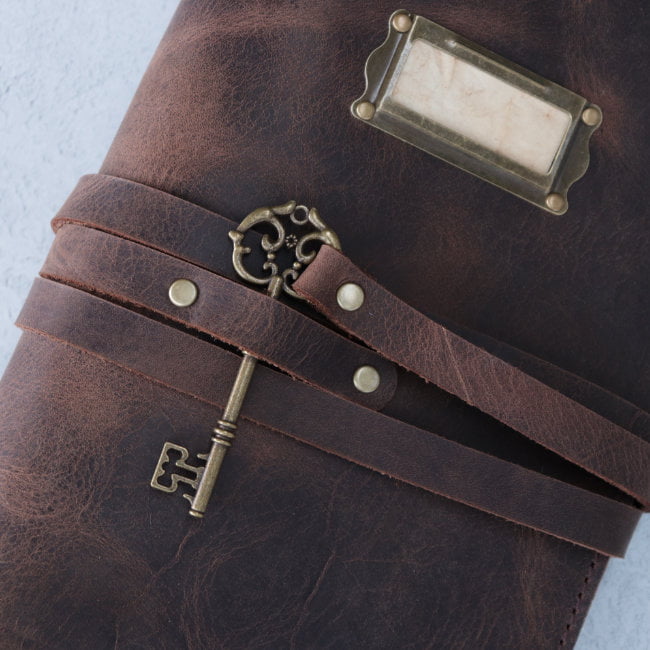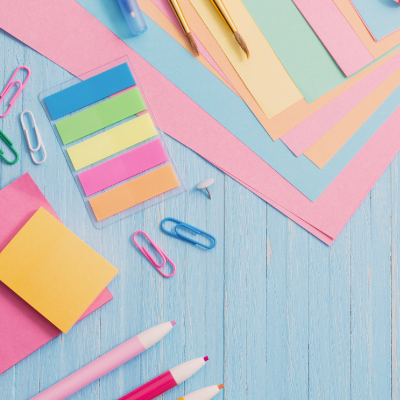When you physically write things down, it helps commit these things to memory. So when it comes to writing out your goals, plans or thoughts – this can be powerful.
There are numerous ways you can use a leather journal. You may only find some of these ideas useful for you, then again – you may want to do all of these things! In that case, you may need more than one leather journal – or you could use multiple softcover notebooks, separate them per topic and keep them all in one leather journal.
When you use your leather journal on a regular (if not daily) basis, you’ll see how it can provide insights, ideas and clarification that can really help you level up in life.


Below is a list of all the ideas for how you can use a leather journal:
- Goals
- Wish list
- Bucket list
- Gratitude journal
- Health & well-being journal
- Food diary
- Budgeting
- Stress and anxiety journaling
- Travel plans
- Bullet journaling
- Note taking
- Movie reviews / Book reviews
- Cleaning list
- Shopping list and menu planner
1. Goals
This can be as simple or detailed as you like – dedicate a few pages or a whole notebook to writing down your goals. You can separate them in sections for personal goals, business/work goals, fitness goals etc. If you have many goals and feel overwhelmed, follow this step by step to get your goal list sorted:
- Create a goals ‘master list’ per topic (personal, work etc). This is your ‘brain dump’ – just put everything you’d like to achieve in the next 12 months and beyond.
- Title the next few pages with Jan-Mar, Apr-Jun, Jul-Sep & Oct-Dec. Sectioning it in quarters of the year help you work out when you’d like to achieve the goals from the master list. Start entering them into these pages.
- Now title the next pages by month and enter some goals on each month. You can also transfer this information in your monthly planner.
- Then break down the month’s goals into your weekly / daily planner. Some will take a day, some a whole week. Be realistic with how much you can achieve.
I have also created a pre-printed “Master Task List Management” notebook, available as part of a planner set.
Don’t forget to go back after each month and mark off what you have completed – what a great feeling!


2. Wish list
How many times have you seen something and thought ‘that would be a perfect birthday gift for me!’ but then forgot when family are asking what to get you. Write them all down and when it’s your birthday or Christmas, assess which wish list item you really want. It’s also helpful to curb unnecessary purchases and impulse spending. You can re-visit your wish list every month and see if you still really want that item.
3. Bucket list
Similar to the wish list, but these are things you ‘wish to do’ rather than ‘to have’. It could be adventures you’d like to go on, countries to visit, places to eat, sports to try, bands to see. You can start with 1 or 2 items, then add as you think of new things to add. Tick off the things you have done.
4. Gratitude journal
You could dedicate a whole notebook to list things you are grateful for at any time of your life or note them down as a daily, weekly or monthly routine. Sometimes it’s hard to remember all the little but important things that you achieved, and it’s great to have a place to write them down and give them the appreciation they deserve – instead of getting stuck in the daily grind and wondering what on earth you did with your time!
Writing things you are grateful for also helps ground you & helps you appreciate life, instead of just going through the motions and getting stuck in the daily grind. It is a great way to look from the outside in.
I write short monthly reflections and include little photos as a visual reminder in my notebook, and I love looking back at them – especially at the end of each year.


5. Health & well-being journal
Keep track of your fitness goals and your progress in reaching them. You can include your actual fitness routines & a habit tracker to mark off each time you have completed your routine. Keep a habit tracker to ensure you are taking in enough water every day or to remember your medication types and amounts. Create graphs or charts to track your moods & emotions by using colour and see if there’s a pattern throughout the month or if something seems a little off – you can investigate why that might be.
6. Food diary
This one could be used either to keep track of eating healthy or as a foodie journal, to write down the favourite meals you’ve cooked, recipes you like or restaurants you’ve visited and must go back to. You could also keep a section in here for wine or beer tastings – soak the labels off the bottles and stick them here. That’s an easy way to remember which ones you liked and should buy again!
7. Budgeting
Keep track of your finances, work out budgets and financial goals on paper and off the cloud. That’s all I have to say about that – not very exciting, but very functional 🙂


8. Stress & anxiety journaling
Writing about what bothers you is the opposite to keeping something bottled up. And we know that keeping stress bottled up is not good for anyone. When we journal for stress, it helps us release the tension and allows us to uncover the root causes of our stress. If we keep it within, it can build up – we think scattered, we repeat scenarios in our head as if that will help make it go away, we can’t concentrate and we get into a vicious cycle.
Have you ever written an angry response to an email, and then deleted it before writing a much nicer email? It helps because it gets it out of our system and once we see it written down, it helps us move on. This is what stress journaling is like. Include all the f-bombs you need and get it all out.
9. Travel plans
Write down future travel plans or places you’d like to visit. Make a few master lists of ‘things to pack’ – whether it’s for international travel or camping. Make it a travel journal where you take short notes of the places you’ve been and things you did, including quick sketches, little photos and Google Map print outs of your trip.
10. Bullet journaling
Learn how to bullet journal as a way of keeping a daily planner / diary. Bullet journaling is a less structured and highly customisable way of keeping a daily planner. You can do so in a 256 page hard cover notebook, or multiple 64-page soft cover notebooks. You can use dot-grid, grid or lined paper to achieve multiple page layouts. You can keep it a minimal and functional or creative and artsy as you like too.
11. Note taking
Imagine simply using a notebook for note taking! Do it in style and bring a leather journal along with you to meetings or lectures. You could have a small A6 size as an easy carry around, or a larger A5 size that could include your notebook plus extra books dedicated as your planner, goals and tracking – as mentioned in the previous points.
12. Movie reviews / Book reviews
If you are a movie buff or bookworm and like to keep track of what you have watched or read, you can take it further by writing a small review on what you thought as well. Perhaps you’ve watched or read something so deep and complex, you need to jot down your thoughts and theories before you share them in a like-minded forum.
13. Cleaning list
Hear me out before you stop reading! Creating a master cleaning list (there’s so many things that get forgotten like under the bed and behind the TV), can help you keep a clean place without feeling overwhelmed by it all. Create a full master list then designate items to a monthly, fortnightly and weekly. Create a checklist if you need to, or transfer over the information to your weekly planner and check it off there.
14. Shopping list & menu planner
Oh to have a stylish leather journal to use as a shopping list & menu planner 😍 Separate your notebook with a master shopping list at the front – of all the essentials you usually buy, and even add your preferred brands to the list. This is soooo helpful if you share the shopping task with someone else. We can spend so much time choosing which brand to buy based on the ingredients list and where the product was manufactured (and which country owns the brand) – and it can get overwhelming! By having this information at the front of your notebook, plus the rest of the pages for your shopping checklist – this should make for a smoother and happier process. Because let’s face it, food shopping is not the most fun.
Use another notebook insert for your menu list (favourite recipe index) and another notebook insert for menu planning. Now you have all your food organisation in the one area. If you haven’t menu planned before – do yourself (and your future self) a huge favour – and start doing it! I’ve written an article to help you get on the way to being a menu planning super-star! You will save both time and money by doing so. Cooking ends up being far more enjoyable as well.
I have also created a pre-printed combined menu planner / shopping list notebook, available in A6 and A5 sizes.


